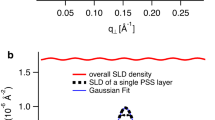Abstract
A new method is introduced to build up organic/organic multilayer films composed of cationic poly(allylamine hydrochloride) (PAH) and negatively charged poly(sodium 4-styrenesulfonate) (PSS) by using the spinning process. The adsorption process is governed by both the viscous force induced by fast solvent elimination and the electrostatic interaction between oppositely charged species. On the other hand, the centrifugal and air shear forces applied by the spinning process significantly enhance the desorption of weakly bound polyelectrolyte chains and also induce the planarization of the adsorbed polyelectrolyte layer. The film thickness per bilayer adsorbed by the conventional dipping process and the spinning process was found to be about 4 å and 24 å, respectively. The surface of the multilayer films prepared with the spinning process is quite homogeneous and smooth. Electroluminescence (EL) devices composed of alternating poly(p-phenylene vinylene) (PPV) and polyanions films show higher quantum efficiency when prepared by the spin self-assembly (SA) method.
Similar content being viewed by others
References
Chou, F. C. and Wu, P.-Y., “Effect of Air Shear on Film Planarization During Spin Coating,”J. Electrochem. Soc.,147, 699 (2000).
Cho, J., Char, K., Kim, S.Y., Hong, J.-D., Lee, S.K. and Kim, D.Y., “Effect of Added Ionic Salt on the Quantum Efficiency of Self-assembled Films Prepared with Poly(p-phenylene vinylene),”Thin Solid Films,379, 188 (2000).
Decher, G., “Fuzzy Nanoassemblies: Toward Layered Polymeric Multicomposites,”Science,277, 1232 (1997).
Flack, W.W., Soong, D. S., Bell, A. T. and Hess, D.W., “A Mathematical Model for Spin Coating of Polymer Resists,”J. Appl. Phys.,56, 1199 (1984).
He, Y., Gong, S., Hattori, R. and Kanicki, J., “High Performance Organic Polymer Light-Emitting Heterostructure Devices,”Appl. Phys. Lett.,74, 2265 (1999).
Ho, P. K. H., Kim, J. S., Burroughes, J. H., Becker, H., Li, S. F. Y., Brown, T.M., Cacialli, F. and Friend, R. H., “Molecular-scale Interface Engineering for Polymer Light-Emitting Diodes,”Nature,404, 481 (2000).
Ho, P. K. H., Granstrom, M., Friend, R. H. and Greenham, N. C., “Ultrathin Self-Assembled Layers at the ITO Interface to Control Charge Injection and Electroluminescence Efficiency in Polymer Light-Emitting Diodes,”Adv. Mater.,10, 769 (1998).
Hong, H., Steitz, R., Kirstein, S. and Davidov, D., “Superlattice Structures in Poly(phenylene vinylene)-Based Self-Assembled Films,”Adv. Mater. 10, 104 (1998).
Kim, J. S., Nam, T.Y. and Huh, Y. J., “The Optical Characteristics in the Layers of Compact Disc-Recordable,”Korean J. Chem. Eng.,14, 88 (1997).
Kotov, N., Dekang, I. and Fendler, J. H., “Layer-by-layer Self-Assembly of Polyelectrolyte-Semiconductor Nanoparticle Composite Films,”J. Phys. Chem.,99, 13065 (1995).
Laschewasky, Wischerhoff, E., Kauranen, M. Persoons, A., “Polyelectrolyte Multilayer Assemblies Containing Nonlinear Optical Dyes,”Macromolecules,30, 8304 (1997).
Lawrence, C. J., “The Mechanics of Spin Coating of Polymer Films,”Phys. Fluids,31, 2786 (1988).
Lenahan, K.M., Wang, Y. X., Liu, Y. J., Claus, R.O., Heflin, J.R., Marciu, D. and Figura, C., “Novel Polymer Dyes for Nonlinear Optical Applications Using Ionic Self-Assembled Monolayer Technology,”Adv. Mater.,10, 853 (1998).
Lvov, Y., Ariga, K., Ichinose, I. and Kunitake, T., “Assembly of Multicomponent Protein Films by Means of Electrostatic Layer-by-layer Adsorption,”J. Am. Chem. Soc.,117, 6117 (1995).
Mendelson, J. D., Barrett, C. J., Chan, V.V., Pal, A. J., Mayes, A.M. and Rubner, M. F., “Fabrication of Microporous Thin Films from Polyelectrolyte Multilayers,”Langmuir,16, 5017 (2000).
Meyerhofer, D., “Characteristics of Resist Films Produced by Spinning,”J. Appl. Phys.,49, 3973 (1978).
Ohara, T., Matsumoto, Y. and Ohasi, H., “The Film Formation Dynamics in Spin Coating,”Phys. Fluids A,1, 1949 (1989).
Onitsuka, O., Fou, A. C., Ferreira, M., Hsieh, B. R. and Rubner, M. F., “Enhancement of Lightemitting Diodes Based on Self-assembled Heterostructures of Poly(p-phenylene vinylene),”J. Appl. Phys.,80, 4067 (1996).
Park, Y. O., Park, H. S., Park, S. J., Kim, S. D., Choi, H.K. and Lim, J. H., “Development and Evaluation of Multilayer Air Filter Media,”Korean J. Chem. Eng.,18, 1020 (2001).
Zhang, X. and Shen, J., “Self-assembled Ultrathin Films from Layered Nanoarchitectures to Functional Assemblies,”Adv. Mater.,11, 1139 (1999).
Author information
Authors and Affiliations
Corresponding author
Rights and permissions
About this article
Cite this article
Cho, J., Kim, S. & Char, K. Fabrication of highly ordered multilayer thin films and its applications. Korean J. Chem. Eng. 20, 174–179 (2003). https://doi.org/10.1007/BF02697205
Received:
Accepted:
Issue Date:
DOI: https://doi.org/10.1007/BF02697205




